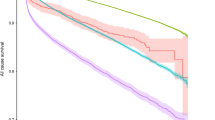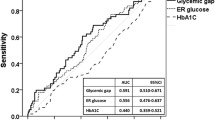Abstract
The relevance of classifying hyperglycemic hospitalized subjects (HS) as known diabetes (D), newly discovered diabetes (ND), and stress hyperglycemia (SH) is unclear. The aim of this study was to determine the prevalence, in-hospital mortality, and length of stay (LOS) of three different phenotypes of HS. Fasting glucose ≥126 mg/dL (7 mmol/L) or random blood glucose ≥200 mg/dL (11.1 mmol/L) defined HS who were categorized into three groups: D; ND (no history of diabetes and HbA1c ≥48 mmol/mol); SH (no history of diabetes and HbA1c <48 mmol/mol). The end points of the study were in-hospital mortality and LOS. Of 1447 consecutive enrolled subjects, the prevalence of HS was 28.6 % (415/1447), of these 71.6 % had D, 21.2 % SH, and 7.2 % ND, respectively. In-hospital death was 3.9 % in normoglycemic and 6.0 % in hyperglycemic subjects. Individuals with SH had an increased risk of in-hospital death (7.9 %) (HR 2.17, 95 % CI 1.18–4.9; p = 0.039), while this was not observed for D and ND patients. The mean LOS was greater in ND and SH subjects. Hyperglycemia is common, and is associated with an increased risk of in-hospital mortality and extension of hospital stay. HbA1c along with clinical history is a useful tool to identify subgroups of hyperglycemic hospitalized subjects. Individuals with SH have a longer LOS, and a double risk of in-hospital mortality. Additionally, identifying previously unknown diabetes represents a remarkable opportunity for prevention of diabetes-related acute and chronic complications.
Similar content being viewed by others
References
Moghissi ES, Korytkowski MT, DiNardo M, Einhorn D, Hellman R, Hirsch IB, Inzucchi SE, Ismail-Beigi F, Kirkman MS, Umpierrez GE, American Association of Clinical Endocrinologists, American Diabetes Association (2009) American association of clinical endocrinologists and American diabetes association consensus statement on inpatient glycemic control. Diabetes Care 32:1119–1131
Umpierrez GE, Isaacs SD, Bazargan N, You X, Thaler LM, Kitabchi AE (2002) Hyperglycemia: an independent marker of in-hospital mortality in patients with undiagnosed diabetes. J Clin Endocrinol Metab 87:978–982
Capes SE, Hunt D, Malmberg K, Pathak P, Gerstein HC (2001) Stress hyperglycemia and prognosis of stroke in nondiabetic and diabetic patients: a systematic overview. Stroke 32:2426–2432
Chen PC, Chua SK, Hung HF, Huang CY, Lin CM, Lai SM, Chen YL, Cheng JJ, Chiu CZ, Lee SH, Lo HM, Shyu KG (2014) Admission hyperglycemia predicts poorer short- and long-term outcomes after primary percutaneous coronary intervention for ST-elevation myocardial infarction. J Diabetes Investig 5:80–86
Bochicchio GV, Sung J, Joshi M, Bochicchio K, Johnson SB, Meyer W, Scalea TM (2005) Persistent hyperglycemia is predictive of outcome in critically ill trauma patients. J Trauma 58:921–924
Gabbanelli V, Pantanetti S, Donati A, Principi T, Pelaia P (2005) Correlation between hyperglycemia and mortality in a medical and surgical intensive care unit. Minerva Anestesiol 71:717–725
Deedwania P, Kosiborod M, Barrett E, Ceriello A, Isley W, Mazzone T, Raskin P, American Heart Association Diabetes Committee of the Council on Nutrition, Physical Activity, and Metabolism (2008) Hyperglycemia and acute coronary syndrome: a scientific statement from the American heart association diabetes committee of the council on nutrition, physical activity, and metabolism. Circulation 117:1610–1619
Pres D, Gasior M, Strojek K, Gierlotka M, Hawranek M, Lekston A, Wilczek K, Tajstra M, Gumprecht J, Poloński L (2010) Blood glucose level on admission determines in-hospital and long-term mortality in patients with ST-segment elevation myocardial infarction complicated by cardiogenic shock treated with percutaneous coronary intervention. Kardiol Pol 68:743–751
Lazzeri C, Valente S, Gensini GF (2014) Hyperglycemia in acute heart failure: an opportunity to intervene? Curr Heart Fail Rep 11:241–245
Capes SE, Hunt D, Malmberg K, Gerstein HC (2000) Stress hyperglycaemia and increased risk of death after myocardial infarction in patients with and without diabetes: a systematic overview. Lancet 355:773–778
Kosiborod M, Rathore SS, Inzucchi SE, Masoudi FA, Wang Y, Havranek EP, Krumholz HM (2005) Admission glucose and mortality in elderly patients hospitalized with acute myocardial infarction: implications for patients with and without recognized diabetes. Circulation 111:3078–3086
Falciglia M, Freyberg RW, Almenoff PL, D’Alessio DA, Render ML (2009) Hyperglycemia-related mortality in critically ill patients varies with admission diagnosis. Crit Care Med 37:3001–3009
Baker EH, Janaway CH, Philips BJ, Brennan AL, Baines DL, Wood DM, Jones PW (2006) Hyperglycaemia is associated with poor outcomes in patients admitted to hospital with acute exacerbations of chronic obstructive pulmonary disease. Thorax 61:284–289
Clement S, Braithwaite SS, Magee MF, Ahmann A, Smith EP, Schafer RG, Hirsch IB, American Diabetes Association Diabetes in Hospitals Writing Committee (2004) Management of diabetes and hyperglycemia in hospitals. Diabetes Care 27:553–591
McAlister FA, Majumdar SR, Blitz S, Rowe BH, Romney J, Marrie TJ (2005) The relation between hyperglycemia and outcomes in 2,471 patients admitted to the hospital with community-acquired pneumonia. Diabetes Care 28:810–815
McAlister FA, ManJ Bistritz L, AmadH Tandon P (2003) Diabetes and coronary artery bypass surgery: an examination of perioperative glycemic control and outcomes. Diabetes Care 26:1518–1524
Pomposelli JJ, Baxter JK 3rd, Babineau TJ, Pomfret EA, Driscoll DF, Forse RA, Bistrian BR (1998) Early postoperative glucose control predicts nosocomial infection rate in diabetic patients. JPEN J Parenter Enteral Nutr 22:77–81
Burt MG, Roberts GW, Aguilar-Loza NR, Quinn SJ, Frith PA, Stranks SN (2013) Relationship between glycaemia and length of hospital stay during an acute exacerbation of chronic obstructive pulmonary disease. Intern Med J 43:721–724
Rapi S, Salti S, Peruzzi B, Veroni F (2014) Point-of-care testing (POCT) networks: verification of glucose meter (accucheck inform II) performance by a quality assessment program managed by the central laboratory. J Near-Patient Test Technol 13(1):18–20
Morgan RJM, Williams F, Wright MM (1997) An early warning scoring system for detecting developing critical illness. Clin Intensive Care 8:100
Subbe CP, Kruger M, Gemmel L (2001) Validation of a modified early warning score in medical admissions. Q J Med 94:521–526
American Diabetes Association (2014) Standards of medical care in diabetes—2014. Diabetes Care 37:14–80
Inzucchi SE (2006) Clinical practice. Management of hyperglycemia in the hospital setting. N Engl J Med 355:1903–1911
http://ars.toscana.it/. Accessed 15 Dec 2014
Goldberg PA, Roussel MG, Inzucchi SE (2005) Clinical results of an updated insulin infusion protocol in critically ill patients. Diabetes Spectr 18:188–191
Ku SY, Sayre CA, Hirsch IB, Kelly JL (2005) New insulin infusion protocol improves blood glucose control in hospitalized patients without increasing hypoglycemia. Jt Comm J Qual Patient Saf 31:141–147
Malmberg K, Ryden L, Efendic S, Herlitz J, Nicol P, Waldenström A, Wedel H, Welin L (1995) Randomized trial of insulin-glucose infusion followed by subcutaneous insulin treatment in diabetic patients with acute myocardial infarction (DIGAMI Study): effects on mortality at 1 year. J Am Coll Cardiol 26:57–65
Moghissi ES, Hirsch IB (2005) Hospital management of diabetes. Endocrinol Metab Clin North Am 34:99–116
Furnary AP, Gao G, Grunkemeier GL, Wu Y, Zerr KJ, Bookin SO, Floten HS, Starr A (2003) Continuous Insulin infusion reduces mortality in patients with diabetes undergoing coronary artery bypass grafting. J Thorac Cardiovasc Surg 125:1007–1021
Markovitz LJ, Wiechmann RJ, Harris N, Hayden V, Cooper J, Johnson G, Harelstad R, Calkins L, Braithwaite SS (2002) Description and evaluation of a glycemic management protocol for patients with diabetes undergoing heart surgery. Endocr Pract 8:10–18
Goldberg PA, Siegel MD, Sherwin RS, Halickman JI, Lee M, Bailey VA, Lee SL, Dziura JD, Inzucchi SE (2004) Implementation of a safe and effective insulin infusion protocol in a medical intensive care unit. Diabetes Care 27:461–467
Meijering S, Corsjens A, Tulleken JE, Meertens JHJM, Zijlstra JG, Ligtenberg JM (2006) Towards a feasible algorithm for tight glycaemic control in critically ill patients: a systematic review of the literature. Crit Care 10:R19
Hirsch IB (2005) Insulin analogues. N Engl J Med 352:174–183
Riddle MC (2005) Glycemic management of type 2 diabetes: an emerging strategy with oral agents, insulin, and combinations. Endocrinol Metab Clin North Am 34:77–98
Edelman SV, Morello CM (2005) Strategies for insulin therapy in type 2 diabetes. South Med J 98:363–371
Gulli G, Frasson S, Borzì V, Fontanella A, Grandi M, Marengo C, Nicolucci A, Pastorelli R, Solerte B, Gatti A, Raimondo FC, Bonizzoni E, Gussoni G, Mazzone A, Ceriello A (2014) Effectiveness of an educational intervention on the management of type 2 diabetic patients hospitalized in internal medicine: results from the FADOI-DIAMOND study. Acta Diabetol 51:765–770
Wright RJ, Frier BM (2008) Vascular disease and diabetes: is hypoglycaemia an aggravating factor? Diabetes Metab Res Rev 24:353–363
Hirsch IB (2012) Understanding low sugar from NICE-SUGAR. N Engl J Med 367:1150–1152
Malhotra A (2006) Intensive insulin in intensive care. N Engl J Med 354:516–518
Umpierrez GE, Kosiborod M (2014) Inpatient dysglycemia and clinical outcomes: association or causation? J Diabetes Complicat 28:427–429
Kosiborod M, Inzucchi SE, Goyal A, Krumholtz HM, Masoudi FA, Xiao L, Spertus JA (2009) Relationship between spontaneous and iatrogenic hypoglycemia and mortality in patients hospitalized with acute myocardial infarction. JAMA 301:1556–1564
Greci LS, Kailasam M, Malkani S, Katz DL, Hulinsky I, Ahmadi R, Nawaz H (2003) Utility of HbA1c levels for diabetes case finding in hospitalized patients with hyperglycemia. Diabetes Care 26:1064–1068
Acknowledgments
The authors are grateful to all patients participating in the study and to the medical and nursing staff providing continuous care and assistance. The authors also wish to thank Jamie Linda Morris for the language editing of the manuscript.
Author information
Authors and Affiliations
Corresponding author
Ethics declarations
Conflict of interest
The authors declare that they have no conflict of interest.
Statement of human and animal rights
All procedures performed in studies involving human participants were in accordance with the ethical standards of the institutional or national research committee, and with the 1964 Helsinki declaration and its later amendments or comparable ethical standards.
Informed consent
Written informed consent was obtained from the patients for publication of the article.
Rights and permissions
About this article
Cite this article
Pieralli, F., Bazzini, C., Fabbri, A. et al. The classification of hospitalized patients with hyperglycemia and its implication on outcome: results from a prospective observational study in Internal Medicine. Intern Emerg Med 11, 649–656 (2016). https://doi.org/10.1007/s11739-015-1358-6
Received:
Accepted:
Published:
Issue Date:
DOI: https://doi.org/10.1007/s11739-015-1358-6




